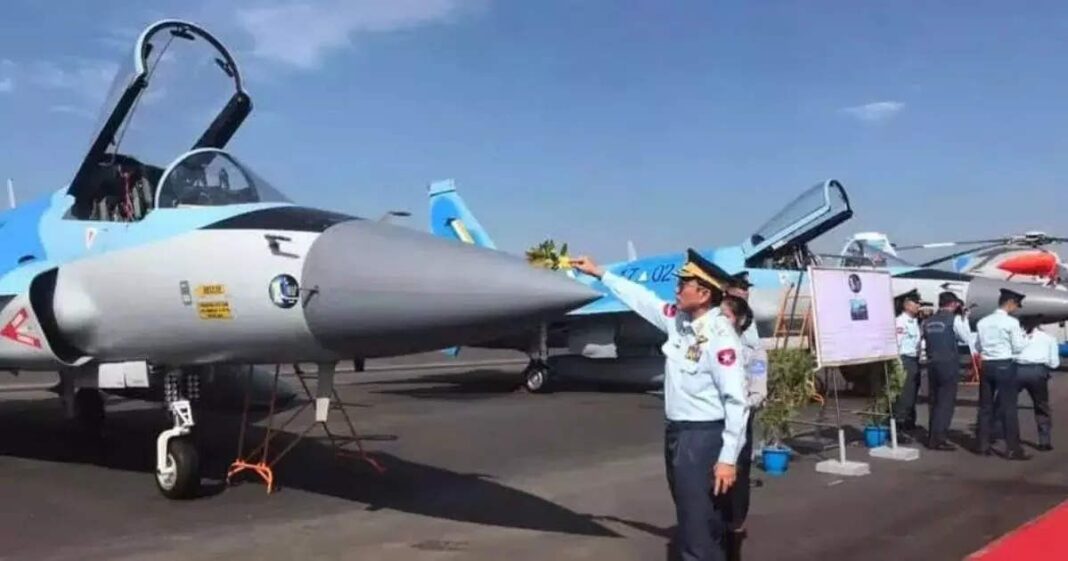In 2016, Myanmar signed a contract to buy 16 JF-17s from China for US$25 million each. The Myanmar Air Force received the first batch of six aircraft in 2018, while the status of the other ten aircraft is unknown.
The JF-17 costs between $15 million and $25 million per aircraft, making it significantly less expensive than almost every other fourth-generation fighter currently available. With the purchase of JF-17s, Myanmar became the first nation outside of Pakistan to have a fleet of this aircraft.
However, the JF-17 jets that the Myanmar Air Force has introduced to its Air Force have structural flaws and other technical problems, according to the report, which quoted defense analysts and retired Myanmar Air Force pilots.
The aircraft, which are meant to conduct interception, ground attacks, and bombing missions, have proven to be inoperable. The Myanmar military lacks the technological know-how to resolve the issues.
The JF-17, jointly produced by Pakistan Aeronautical Complex and China’s Chengdu Aerospace Corporation, was primarily developed to counterbalance the Indian Air Force. The aircraft is outfitted with cutting-edge avionics, powered by Russian engines, and incorporates a Chinese-made airframe.
The China-made KLJ-7 Al radar is an important component of the JF-17 avionics. However, the radar system has poor accuracy and requires frequent maintenance. The aircraft can carry 500-lb bombs, 80mm and 240mm rockets, and air-to-air mid-range guided missiles.

A former Myanmar Air Force pilot told the outlet that when an aircraft experiences severe gravitational pressures, the airframe is susceptible to damage, particularly in its wingtips and hardpoints.
Additionally, it was stated that the JF-17 program is currently in a rut because there aren’t enough spare parts for the Russian-made Klimov RD-93 aircraft engine. The US imposed sanctions on Russian arms giant Rosoboronexport, which exported RD-93 engines and spare parts in 2018.
However, Myanmar is not the only country dealing with these difficulties. Last year, it was reported that Pakistan’s JF-17 Thunder has turned out to be a headache for Islamabad due to its high operational and maintenance costs compared to more modern weapons.
Factors Behind Poor Operational Capabilities
The Myanmar military bought the JF-17 fighter jets through middlemen between 2015 and 2020, as the avionics and electronics were produced with components from Western nations.
Four years after they were commissioned, the JF-17s still cannot be used for combat by the Myanmar Air Force because of their subpar accuracy. According to observers, this has forced Myanmar’s Air Force to depend on Russian-made Yak-130 and MiG-29 fighter jets and Chinese K-8 fighters.
The report said that the Air Force is currently without spare parts for the JF-17s because of sanctions the European Union placed after the coup against the military and arms dealers in Myanmar.
Furthermore, the trade restriction also prevents the military regime in Myanmar from directly purchasing missiles and bombs for its JF-17s.

The Myanmar Air Force purportedly held discussions with Islamabad to acquire air-to-surface missiles, together with bombs and rockets, to undertake lethal air strikes against civilians and ethnic-armed revolutionary organizations.
A cargo plane from Pakistan carrying JF-17 spare parts reportedly arrived in Myanmar sometime in May this year.
In the meantime, the regime has established a relationship with the Pakistani military and periodically sends weapons system officers from the Air Force and Air Defense units for training.
During an unannounced trip to Myanmar in September, Pakistani Air Force engineers installed a JF-17 simulator at Pathein Air Base for the pilots of the Myanmar Air Force and addressed a few technical issues.
However, according to the report, a JF-17 weapons system officer stated that the JF-17’s weapons system is too technically sophisticated for pilots of Myanmar’s Air Force to operate.
Overall, the shortage of spare parts has drastically reduced the aircraft’s combat capabilities and now turned them into a burden for Myanmar’s Air Force.
eurasiantimes

